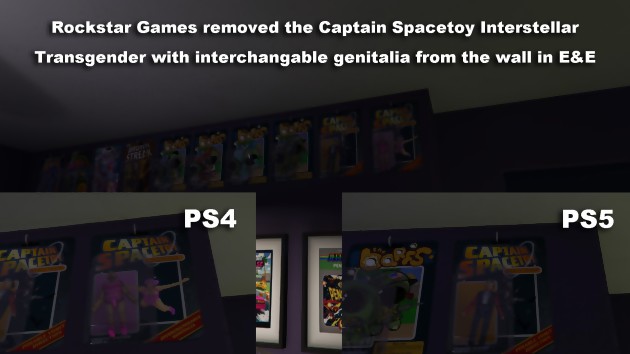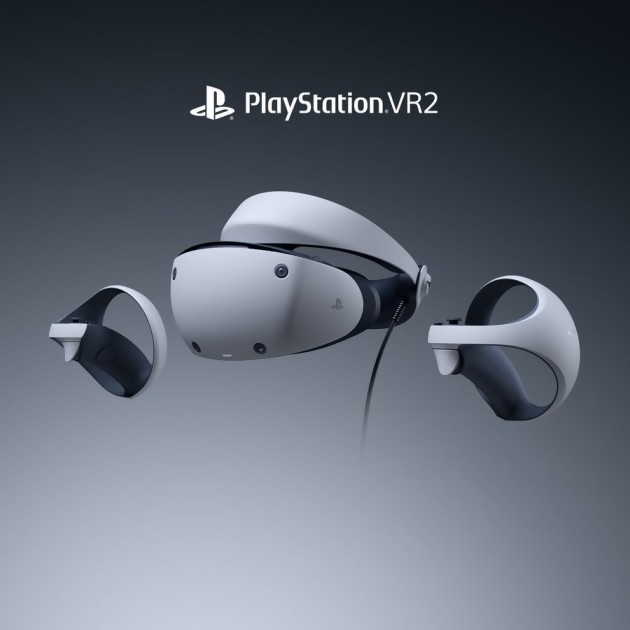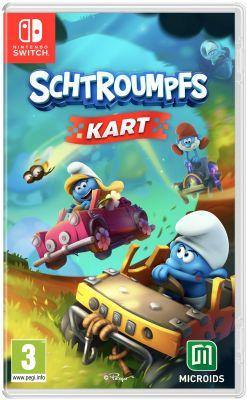 While young Serge is in the middle of a semi-gallant rendezvous with Lena on the beach bordering their native village, he suddenly loses consciousness and then comes to his senses alone, in the same place. At least that's what he thinks at first, but the return to the village will quickly raise serious questions. Not only does Lena not recognize him, but she also tells him that the Serge he claims to be died ten years earlier at the age of seven. This starting point is that of a cult adventure, which plays with parallel dimensions just as its famous predecessor Chrono Trigger played with time. Chrono Cross is a Japanese role-playing game with a rich storyline, filled with endearing characters (including the many playable heroes), which takes place in a fantasy universe (in both senses of the word), and which offers some important choices leading for multiple purposes. All its qualities are of course intact in this remaster, which we welcome with all the more pleasure as the adventure has never before been released in Europe. It is therefore finally possible to enjoy it legally, and in French moreover!
While young Serge is in the middle of a semi-gallant rendezvous with Lena on the beach bordering their native village, he suddenly loses consciousness and then comes to his senses alone, in the same place. At least that's what he thinks at first, but the return to the village will quickly raise serious questions. Not only does Lena not recognize him, but she also tells him that the Serge he claims to be died ten years earlier at the age of seven. This starting point is that of a cult adventure, which plays with parallel dimensions just as its famous predecessor Chrono Trigger played with time. Chrono Cross is a Japanese role-playing game with a rich storyline, filled with endearing characters (including the many playable heroes), which takes place in a fantasy universe (in both senses of the word), and which offers some important choices leading for multiple purposes. All its qualities are of course intact in this remaster, which we welcome with all the more pleasure as the adventure has never before been released in Europe. It is therefore finally possible to enjoy it legally, and in French moreover!
The visual improvements in this remaster are pretty tentative and disappointing anyway. The character models have been reworked with more detailed textures, yes, but they are still just as low polygon. As for the 2D backgrounds that used to be pixelated, they have obviously been put through the mill of artificial intelligence...
This is not the only advantage of this edition which, as its name suggests, also includes Radical Dreamers. Until today, this essentially textual adventure dedicated to the Chrono universe was only available in Japan on Satellaview, a satellite device dedicated to the Super NES. Suffice to say that not many people had yet had the opportunity to enjoy it here. And we didn't know what we were missing! This new section, which takes up (with a twist) characters and situations from the main game, really thrilled us. Its structure is reminiscent of tabletop role-playing games of yesteryear, the system of life points hidden behind simple sentences is very clever, the life span extends from four to twelve hours depending on the number of endings the we seek to achieve, and the French translation is worthy of the highest praise. It dares the simple past ("I defended myself", "we arrived"…) and offers turns of phrase and a vocabulary much more sought after than the average of current video game productions.
REMASTER OLD SCHOOL
 But back to the main adventure, whose combat system should also be commended. It consists above all of attacks divided into three levels (weak, strong, and formidable), whose chances of success are inversely proportional to their power. But the success percentage, which is clearly displayed on the screen, increases for all levels after each hit. The basic technique is therefore to start with a weak attack in order to increase the chances of success of the more powerful blows, but sometimes it can also pay off to try to land a big blow directly. That's not all, because the game also offers a system of elements, which correspond both to spells that can be used once per fight and to consumables whose use is limited only by their quantity. These elements can be of different colors, which is of crucial importance since a gauge called Field Effect and divided into three sections allows, if you play finely, to increase the power of attacks tenfold. Indeed, when an enemy or an ally uses an element, one of the sections takes on the corresponding color. And if we manage to fill the gauge with one and the same color, the effectiveness of the group of elements of this color then increases significantly. In addition, each character also has an "innate" color and is weaker against attacks of the opposite color. It is therefore important to have elements of each color with you, and to use them tactically in order to maximize the effectiveness of our moves.
But back to the main adventure, whose combat system should also be commended. It consists above all of attacks divided into three levels (weak, strong, and formidable), whose chances of success are inversely proportional to their power. But the success percentage, which is clearly displayed on the screen, increases for all levels after each hit. The basic technique is therefore to start with a weak attack in order to increase the chances of success of the more powerful blows, but sometimes it can also pay off to try to land a big blow directly. That's not all, because the game also offers a system of elements, which correspond both to spells that can be used once per fight and to consumables whose use is limited only by their quantity. These elements can be of different colors, which is of crucial importance since a gauge called Field Effect and divided into three sections allows, if you play finely, to increase the power of attacks tenfold. Indeed, when an enemy or an ally uses an element, one of the sections takes on the corresponding color. And if we manage to fill the gauge with one and the same color, the effectiveness of the group of elements of this color then increases significantly. In addition, each character also has an "innate" color and is weaker against attacks of the opposite color. It is therefore important to have elements of each color with you, and to use them tactically in order to maximize the effectiveness of our moves.
GOOD BACKGROUND, BUT SMALL SHAPE
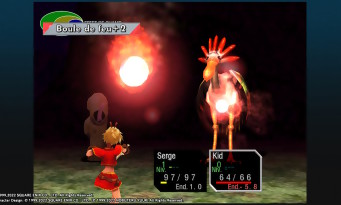 And since we're on the subject of efficiency, it's worth giving credit to the quality of life improvements this remaster brings. With a simple press of a stick, it is possible to deactivate (and reactivate at will) random encounters, this typically JRPG concept having aged quite badly. Better yet, an equally easily accessible option allows you to trigger combat automation. This is obviously to be avoided during major confrontations, but it makes it easier to pass the simplest or most unbalanced battles, those that are settled by putting on the basic attacks without thinking. Especially since this option is compatible with the acceleration function, which also saves time during the exploration phases. A "combat bonus" option is even available for players who have trouble with the balance of yesteryear. It is roughly similar to a cheat code since it allows you to avoid all enemy attacks. Purists will not only be able to do without all that, but also launch the game without any modern graphic improvements, a classic mode being offered in the main menu.
And since we're on the subject of efficiency, it's worth giving credit to the quality of life improvements this remaster brings. With a simple press of a stick, it is possible to deactivate (and reactivate at will) random encounters, this typically JRPG concept having aged quite badly. Better yet, an equally easily accessible option allows you to trigger combat automation. This is obviously to be avoided during major confrontations, but it makes it easier to pass the simplest or most unbalanced battles, those that are settled by putting on the basic attacks without thinking. Especially since this option is compatible with the acceleration function, which also saves time during the exploration phases. A "combat bonus" option is even available for players who have trouble with the balance of yesteryear. It is roughly similar to a cheat code since it allows you to avoid all enemy attacks. Purists will not only be able to do without all that, but also launch the game without any modern graphic improvements, a classic mode being offered in the main menu.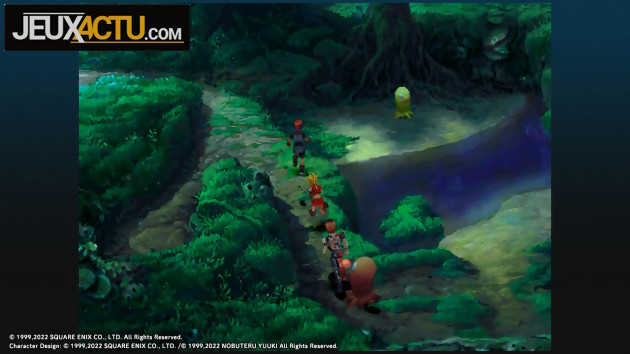
It is unfortunately not possible to zap in real time between the visuals of yesteryear and those of today, an option nevertheless often present elsewhere and very practical (whether to compare such or such point, such or such scene , or treat yourself to a little nostalgic trip from time to time). The visual improvements in this remaster are pretty tentative and disappointing anyway. The character models have been reworked with more detailed textures, yes, but they are still just as low polygon. As for the 2D backgrounds that used to be pixelated, they have obviously been put through the mill of artificial intelligence, since we find the “watercolor” effect typical of this automatic upscaling method. From a distance it works well, but on closer inspection the result really doesn't look very natural. This lack of manual overhaul is also reflected in the image format, which remains confined to 4/3 (even if a zoom option is available). Square Enix is therefore satisfied with the minimum service from the point of view of the facelift. But the worst comes from the framerate, which is particularly low and unstable. While a game dating back to the last century and displaying extremely simple 3D should run at 120 fps on PC and home consoles and 60 fps on Switch, it only aims for 30 frames per second and regularly falls below 20, whatever regardless of the platform used. For once, here is a return to the past that we would have preferred to avoid...




